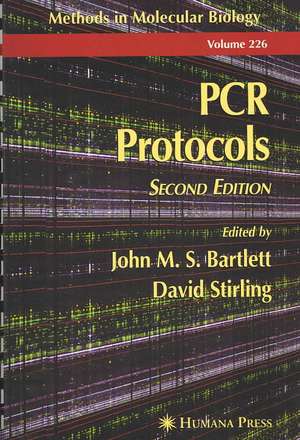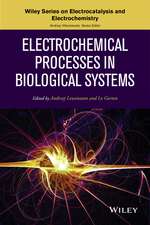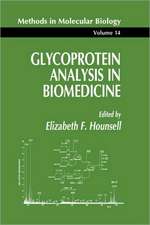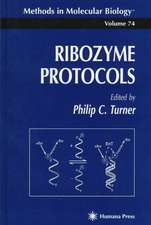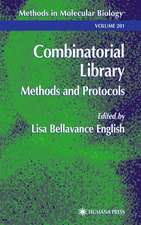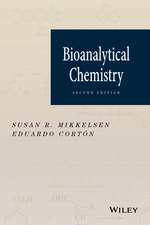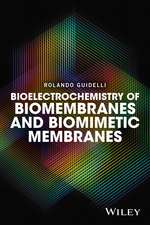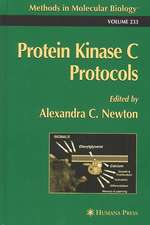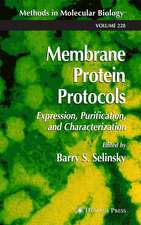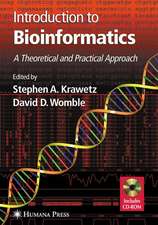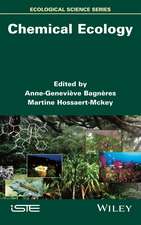PCR Protocols: Methods in Molecular Biology, cartea 226
Editat de John M.S. Bartlett, David Stirlingen Limba Engleză Paperback – aug 2003
Din seria Methods in Molecular Biology
- 9%
 Preț: 791.63 lei
Preț: 791.63 lei - 23%
 Preț: 598.58 lei
Preț: 598.58 lei - 20%
 Preț: 882.98 lei
Preț: 882.98 lei -
 Preț: 252.05 lei
Preț: 252.05 lei - 5%
 Preț: 802.70 lei
Preț: 802.70 lei - 5%
 Preț: 729.61 lei
Preț: 729.61 lei - 5%
 Preț: 731.43 lei
Preț: 731.43 lei - 5%
 Preț: 741.30 lei
Preț: 741.30 lei - 5%
 Preț: 747.16 lei
Preț: 747.16 lei - 15%
 Preț: 663.45 lei
Preț: 663.45 lei - 18%
 Preț: 1025.34 lei
Preț: 1025.34 lei - 5%
 Preț: 734.57 lei
Preț: 734.57 lei - 18%
 Preț: 914.20 lei
Preț: 914.20 lei - 15%
 Preț: 664.61 lei
Preț: 664.61 lei - 15%
 Preț: 654.12 lei
Preț: 654.12 lei - 18%
 Preț: 1414.74 lei
Preț: 1414.74 lei - 5%
 Preț: 742.60 lei
Preț: 742.60 lei - 20%
 Preț: 821.65 lei
Preț: 821.65 lei - 18%
 Preț: 972.30 lei
Preț: 972.30 lei - 15%
 Preț: 660.49 lei
Preț: 660.49 lei - 5%
 Preț: 738.41 lei
Preț: 738.41 lei - 18%
 Preț: 984.92 lei
Preț: 984.92 lei - 5%
 Preț: 733.29 lei
Preț: 733.29 lei -
 Preț: 392.60 lei
Preț: 392.60 lei - 5%
 Preț: 746.26 lei
Preț: 746.26 lei - 18%
 Preț: 962.66 lei
Preț: 962.66 lei - 23%
 Preț: 860.22 lei
Preț: 860.22 lei - 15%
 Preț: 652.64 lei
Preț: 652.64 lei - 5%
 Preț: 1055.50 lei
Preț: 1055.50 lei - 23%
 Preț: 883.87 lei
Preț: 883.87 lei - 19%
 Preț: 491.89 lei
Preț: 491.89 lei - 5%
 Preț: 1038.86 lei
Preț: 1038.86 lei - 5%
 Preț: 524.16 lei
Preț: 524.16 lei - 18%
 Preț: 2122.34 lei
Preț: 2122.34 lei - 5%
 Preț: 1299.23 lei
Preț: 1299.23 lei - 5%
 Preț: 1339.12 lei
Preț: 1339.12 lei - 18%
 Preț: 1390.26 lei
Preț: 1390.26 lei - 18%
 Preț: 1395.63 lei
Preț: 1395.63 lei - 18%
 Preț: 1129.65 lei
Preț: 1129.65 lei - 18%
 Preț: 1408.26 lei
Preț: 1408.26 lei - 18%
 Preț: 1124.92 lei
Preț: 1124.92 lei - 18%
 Preț: 966.27 lei
Preț: 966.27 lei - 5%
 Preț: 1299.99 lei
Preț: 1299.99 lei - 5%
 Preț: 1108.51 lei
Preț: 1108.51 lei - 5%
 Preț: 983.76 lei
Preț: 983.76 lei - 5%
 Preț: 728.16 lei
Preț: 728.16 lei - 18%
 Preț: 1118.62 lei
Preț: 1118.62 lei - 18%
 Preț: 955.25 lei
Preț: 955.25 lei - 5%
 Preț: 1035.62 lei
Preț: 1035.62 lei - 18%
 Preț: 1400.35 lei
Preț: 1400.35 lei
Preț: 668.36 lei
Preț vechi: 786.30 lei
-15% Nou
Puncte Express: 1003
Preț estimativ în valută:
127.93€ • 139.01$ • 107.53£
127.93€ • 139.01$ • 107.53£
Carte tipărită la comandă
Livrare economică 21 aprilie-05 mai
Preluare comenzi: 021 569.72.76
Specificații
ISBN-13: 9780896036277
ISBN-10: 0896036278
Pagini: 556
Ilustrații: 556 p. 42 illus.
Dimensiuni: 178 x 254 x 26 mm
Greutate: 1.19 kg
Ediția:2nd ed. 2003
Editura: Humana Press Inc.
Colecția Humana
Seria Methods in Molecular Biology
Locul publicării:Totowa, NJ, United States
ISBN-10: 0896036278
Pagini: 556
Ilustrații: 556 p. 42 illus.
Dimensiuni: 178 x 254 x 26 mm
Greutate: 1.19 kg
Ediția:2nd ed. 2003
Editura: Humana Press Inc.
Colecția Humana
Seria Methods in Molecular Biology
Locul publicării:Totowa, NJ, United States
Public țintă
ResearchCuprins
1 A Short History of the Polymerase Chain Reaction.- 2 PCR Patent Issues.- 3 Equipping and Establishing a PCR Laboratory.- 4 Quality Control in PCR.- 5 Extraction of Nucleic Acid Templates.- 6 Extraction of DNA from Whole Blood.- 7 DNA Extraction from Tissue.- 8 Extraction of DNA from Microdissected Archival Tissues.- 9 RNA Extraction from Blood.- 10 RNA Extraction from Frozen Tissue.- 11 RNA Extraction from Tissue Sections.- 12 Dual DNA/RNA Extraction.- 13 DNA Extraction from Fungi, Yeast, and Bacteria.- 14 Isolation of RNA Viruses from Biological Materials.- 15 Extraction of Ancient DNA.- 16 DNA Extraction from Plasma and Serum.- 17 Technical Notes for the Detection of Nucleic Acids.- 18 Technical Notes for the Recovery and Purification of PCR Products from Acrylamide Gels.- 19 PCR Primer Design.- 20 Optimization of Polymerase Chain Reactions.- 21 Subcycling PCR for Long-Distance Amplifications of Regions with High and Low Guanine-Cystine Content: Amplification of the Intron 22 Inversion of the FVIII Gene.- 22 Rapid Amplification of cDNA Ends.- 23 Randomly Amplified Polymorphic DNA Fingerprinting: The Basics.- 24 Microsphere-Based Single Nucleotide Polymorphism Genotyping.- 25 Ligase Chain Reaction.- 26 Nested RT-PCR in a Single Closed Tube.- 27 Direct PCR from Serum: Application to Viral Genome Detection.- 28 Long PCR Amplification of Large Fragments of Viral Genomes: A Technical Overview.- 29 Long PCR Methodology.- 30 Qualitative and Quantitative PCR: A Technical Overview.- 31 Ultrasensitive PCR Detection of Tumor Cells in Myeloma.- 32 Ultrasensitive Quantitative PCR to Detect RNA Viruses.- 33 Quantitative PCR for cAMP RI Alpha mRNA: Use of Site-Directed Mutation and PCR Mimics.- 34 Quantitation of Multiple RNA Species.- 35 Differential Display: A Technical Overview.- 36 AU-Differential Display, Reproducibility of a Differential mRNA Display Targeted to AU Motifs.- 37 PCR Fluorescence Differential Display.- 38 Microarray Analysis Using RNA Arbitrarily Primed PCR.- 39 Oligonucleotide Arrays for Genotyping: Enzymatic Methods for Typing Single Nucleotide Polymorphisms and Short Tandem Repeats.- 40 Serial Analysis of Gene Expression.- 41 Mutation and Polymorphism Detection: A Technical Overview.- 42 Combining Multiplex and Touchdown PCR for Microsatellite Analysis.- 43 Detection of Microsatellite Instability and Loss of Heterozygosity Using DNA Extracted from Formalin-Fixed Paraffin-Embedded Tumor Material by Fluorescence-Based Multiplex Microsatellite PCR.- 44 Reaction of Shadow Band Synthesis During PCR Amplification of Repetitive Sequences from Modern and Ancient DNA.- 45 Degenerate Oligonucleotide-Primed PCR.- 46 Mutation Detection Using RT-PCR-RFLP.- 47 Multiplex Amplification Refractory Mutation System for the Detection of Prothrombotic Polymorphisms.- 48 PCR-SSCP Analysis of Polymorphism: A Simple and Sensitive Method for Detecting Differences Between Short Segments of DNA.- 49 Sequencing: A Technical Overview.- 50 Preparation and Direct Automated Cycle Sequencing of PCR Products.- 51 Nonradioactive PCR Sequencing Using Digoxigenin.- 52 Direct Sequencing by Thermal Asymmetric PCR.- 53 Analysis of Nucleotide Sequence Variations by Solid-Phase Minisequencing.- 54 Direct Sequencing with Highly Degenerate and Inosine-Containing Primers.- 55 Determination of Unknown Genomic Sequences Without Cloning.- 56 Cloning PCR Products for Sequencing in M13 Vectors.- 57 DNA Rescue by the Vectorette Method.- 58 Technical Notes for Sequencing Difficult Templates.- 59 PCR-Based Detection of Nucleic Acids in Chromosomes, Cells, and Tissues: Technical Considerations on PRINS and In Situ PCR, and Comparison with In Situ Hybridization.- 60 Cycling Primed In Situ Amplification.- 61 Direct and Indirect In Situ PCR.- 62 Reverse Transcriptase In Situ PCR: New Methods in Cellular Interrogation.- 63 Primed In Situ Nucleic Acid Labeling Combined with Immunocytochemistry to Simultaneously Localize DNA and Proteins in Cells and Chromosomes.- 64 Cloning and Mutagenesis: A Technical Overview.- 65 Using T4 DNA Polymerase to Generate Clonable PCR Products.- 66 A T-Linker Strategy for Modification and Directional Cloning of PCR Products.- 67 Cloning Gene Family Members Using PCR with Degenerate Oligonucleotide Primers.- 68 cDNA Libraries from a Low Amount of Cells.- 69 Creation of Chimeric Junctions, Deletions, and Insertions by PCR.- 70 Recombination and Site-Directed Mutagenesis Using Recombination PCR.- 71 Megaprimer PCR: Application in Mutagenesis and Gene Fusion.
Recenzii
Reviews of the First Edition:
"...succeeds in covering a wider range of more general applicable methods than...its predecessors ...provid[es] an extensive range of versatile, expedient, and readily applicable PCR protocols."-Trends in Cell Biology
From reviews of the first edition...
"...useful in virtually all disciplines of the life sciences...a pleasure [to] read and use..."
-American Journal of Physiology: Lung Cellular and Molecular Physiology
"...an excellent resource...has potential value for anyone looking for new ways to use PCR or new tricks to make their PCR work better."
-Biopharm
"...provides an extensive range of versatile, expedient, and readily applicable PCR protocols."
-Trends in Cell Biology
"...succeeds in covering a wider range of more general applicable methods than...its predecessors ...provid[es] an extensive range of versatile, expedient, and readily applicable PCR protocols."-Trends in Cell Biology
From reviews of the first edition...
"...useful in virtually all disciplines of the life sciences...a pleasure [to] read and use..."
-American Journal of Physiology: Lung Cellular and Molecular Physiology
"...an excellent resource...has potential value for anyone looking for new ways to use PCR or new tricks to make their PCR work better."
-Biopharm
"...provides an extensive range of versatile, expedient, and readily applicable PCR protocols."
-Trends in Cell Biology
Textul de pe ultima copertă
Drawing on the proven qualities of the much praised and widely used first edition, John M. S. Bartlett and David Stirling have thoroughly updated and dramatically expanded the number of protocols to take advantage of the newest technologies used in all branches of research and clinical medicine today. These successful methods include real-time PCR, SNP analysis, nested PCR, direct PCR, and long-range PCR. Among the highlights are chapters on genome profiling by SAGE, differential display and chip technologies, the amplification of whole genome DNA by random degenerate oligonucleotide PCR, and the refinement of PCR methods for the analysis of fragmented DNA from fixed tissues. In situ PCR methods and their application in parallel with other methods, such as immunohistochemistry, are also included. Each fully tested protocol is described in step-by-step detail by an established expert in the field and includes a background introduction outlining the principle behind the technique, equipment and reagent lists, tips on troubleshooting and avoiding known pitfalls, and, where needed, a discussion of the interpretation and use of results.
Cutting-edge and highly practical, PCR Protocols, Second Edition provides both novice and experienced investigators with an up-to-date compendium of powerful PCR methods for easy reference and consultation in the day-to-day performance of PCR-based experimentation, one that will enhance understanding of PCR, satisfy current needs, and point to powerful future applications.
Cutting-edge and highly practical, PCR Protocols, Second Edition provides both novice and experienced investigators with an up-to-date compendium of powerful PCR methods for easy reference and consultation in the day-to-day performance of PCR-based experimentation, one that will enhance understanding of PCR, satisfy current needs, and point to powerful future applications.
Caracteristici
Includes supplementary material: sn.pub/extras
